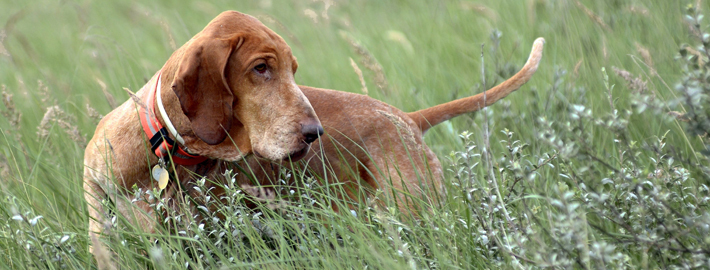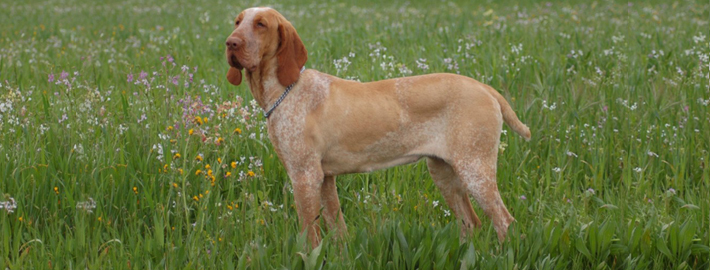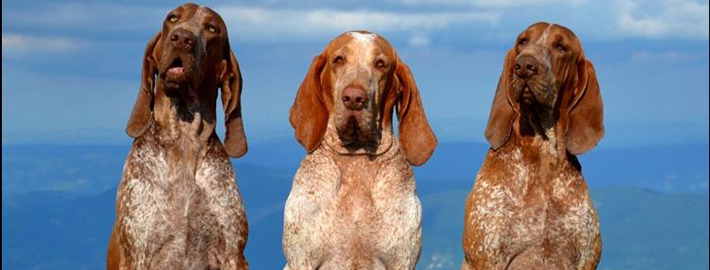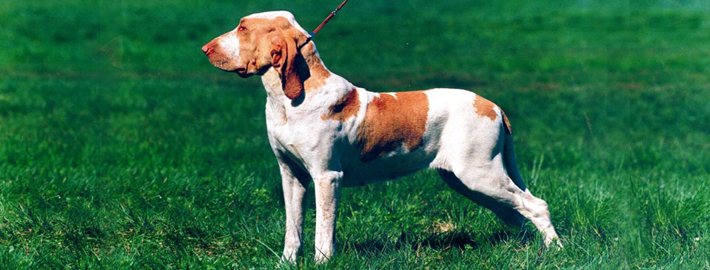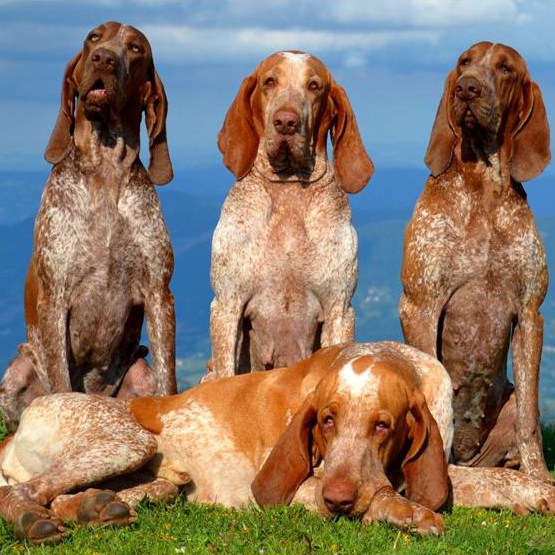What makes the Bracco Italiano Unique?
There is a reason that the large, lovable Bracco Italiano breed has been around for thousands of years. These skilled canines are utterly devoted to their humans and they also quite capable of hunting any type of game that their owners would like.
Breed Groups
Page Contents
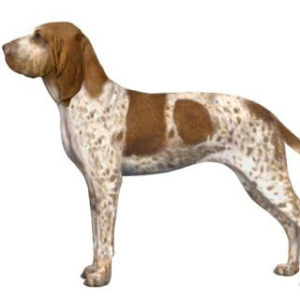
SnapShot
Is the Bracco Italiano Right For You?
Members of this breed are suitable for all forms of hunting as they are capable of both retrieving and pointing. Bracco Italiano dogs are also quite capable of distinguishing the line between work and play. Hardworking in the field, these dogs will make excellent, docile companions when they are at home as long as they have gotten enough exercise. Although they are imposing in appearance, members of this breed are pleasant company. This breed gravitates towards people and individual dogs will become very attached to the human members of their families. Bracco Italiano dogs are playful and make excellent companions for children. They get along well with other dogs but some may have a problem with smaller pets and cats if they are not raised around them. The gentle disposition of a Bracco Italiano negates their use as a guardian but they are excellent watchdogs and will certainly bark if people enter their domain. However, prospective owners should note that these dogs drool a lot and they have a tendency to be messy eaters.
In 5 Words
- Playful
- Loyal
- Companionable
- Stubborn
- Affectionate
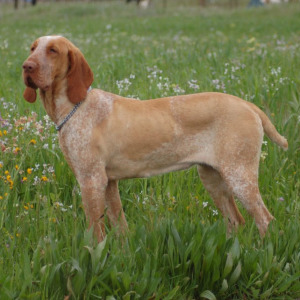
Characteristics
Learn About the Bracco Italiano
Description
General Description
Bracco Italiano dogs are large, square shaped animals with an athletic appearance. Although two different strains of this breed can be found today, one is only slightly darker and heavier in frame than the other. These dogs have narrow heads, domed skulls, curved ribs, deep chests, strong necks, and tucked stomachs. Their sizeable noses should be either flesh colored or pink and their oval eyes should range from ocher to brown. The hue of both the aforementioned features is dependent on a dog’s coat color. Bracco Italiano dogs have long ears with rounded tips that hang close to their cheeks. Members of this breed have a straight tail that is held at the ground level when the dogs are in motion. In places where the practice is not illegal, these dogs will often have their tails docked to between 6 and 10 inches (15 and 25 centimeters) in length.
Coat
Bracco Italiano dogs have short, thick fur with a silky texture. Their coat is flatter on their legs, feet, ears, and head than it is on other parts of their bodies. Members of this breed usually have white fur with.orange, amber, or chestnut markings. In accordance with the United Kennel Club standards, these dogs should have symmetrical face masks. However, those without this feature are also permitted in the show ring.
Size
Male dogs of this breed typically measure between 22.8 and 26.5 inches (58 and 67 centimeters) in height while their female contemporaries stand at 21.7 to 24.4 inches (55 to 62 centimeters) tall. On average, dogs of both genders weigh between 55 and 88 pounds (25 to 40 kilograms).
Short History of the Bracco Italiano
As the name attests, the Bracco Italiano breed comes from Italy. There are historical documents that date these dogs as far back as the 4th century. It is possible that the breed has Segugio Italianoes, Asiatic Mastiffs, and/or St. Hubert’s Hounds among their ancestors. Obviously gundogs and hounds have gone into the makeup of this breed in order to allow them to be able to not only point but also to increase their durability.
By the Middle Ages, Bracco Italiano dogs had become quite popular and they were bred by a number of influential Italian families during the Renaissance. The nobles of the time period used these dogs to hunt various types of birds. Initially, members of this breed would chase flying game into nets that had been set up to ensnare them but, as time progressed, Bracco Italiano dogs turned their skills to retrieving and pointing.
However, the breed eventually went into decline. By the turn of the 20th century, the dogs were almost extinct. Thanks to the dedicated efforts of Italian breeders, some of whom had families that had done so for centuries, the breed eventually made comeback. In 1949, the first official breed standard was released. Bracco Italiano dogs made their way to England some forty years later.
Temperament
Members of this breed are suitable for all forms of hunting as they are capable of both retrieving and pointing. Bracco Italiano dogs are also quite capable of distinguishing the line between work and play. Hardworking in the field, these dogs will make excellent, docile companions when they are at home as long as they have gotten enough exercise. Although they are imposing in appearance, members of this breed are pleasant company. This breed gravitates towards people and individual dogs will become very attached to the human members of their families. Bracco Italiano dogs are playful and make excellent companions for children. They get along well with other dogs but some may have a problem with smaller pets and cats if they are not raised around them. The gentle disposition of a Bracco Italiano negates their use as a guardian but they are excellent watchdogs and will certainly bark if people enter their domain. However, prospective owners should note that these dogs drool a lot and they have a tendency to be messy eaters.
Caring for Your Bracco Italiano
General Health
Members of this breed usually live for about 10 to 12 years. Owners should nonetheless be aware that certain conditions can arise from time to time including hip dysplasia, entropion and kidney disease. Due to the presence of their large chests, these dogs are particularly susceptible to bloat, a condition that is the second most common canine killer after cancer. Anesthesia sensitivity may also occur in many Bracco Italiano dogs.
Care
Daily
Members of this breed require daily exercise if they are not going hunting. Prospective owners should note that these dogs are better suited to open spaces where they can run free rather than city environments. Bracco Italiano dogs that get enough exercise might be able to get by in small houses but, at the very least, they will have to have a fenced yard to play in.
Weekly
Bracco Italiano dog owners will want to clean their pet’s teeth regularly to keep health problems at bay. These dogs also need to be brushed at least once a week in order to control their heavy shedding.
Monthly
Flea, tick, and heartworm prevention medication is a must for all dogs. Most of these products are typically administered on a monthly basis.
Grooming & Bathing
Their ears should be kept clean and their toenails trimmed in order to prevent health problems or injuries from occurring. Members of this breed should also be bathed as needed.
Exercise & Training
Members of this breed have a tendency to chase small animals. They may also growl or bark if someone enters their property. These personality traits mean that a Bracco Italiano must be taught from puppyhood when such behaviors are appropriate and when they are not. Scolding the dogs is sometimes necessary because some individuals have a stubborn streak. However, owners should not use a sharp tone with their pets as this will end up being a counterproductive measure. A Bracco Italiano will ignore reprimands if it does not think its’ owner is being fair. They also will not obey what they perceive to be nonsensical orders. Owners should be aware that some members of this breed are sensitive individuals and plan their lessons accordingly if this happens to be the case for their particular pet.

